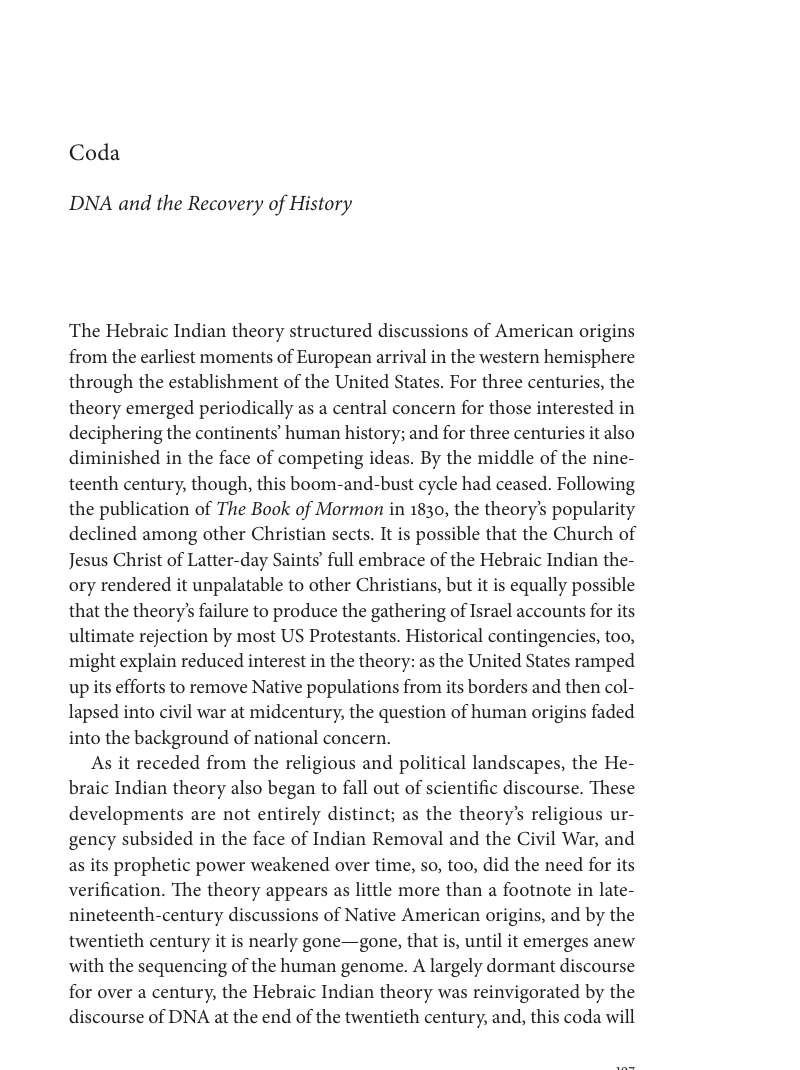Elizabeth Fenton reviews the DNA controversy from a non-LDS perspective.
- Type
- Book
- Source
- Elizabeth Fenton Non-LDS
- Hearsay
- DirectSecondary
- Reference
Elizabeth Fenton, Old Canaan in a New World: Native Americans and the Lost Tribes of Israel (New York: New York University Press, 2020), 197–209
- Scribe/Publisher
- New York University Press
- People
- Elizabeth Fenton
- Audience
- Reading Public
- Transcription
The Hebraic Indian theory structured discussions of American origins from the earliest moments of European arrival in the western hemisphere through the establishment of the United States. For three centuries, the theory emerged periodically as a central concern for those interested in deciphering the continents’ human history; and for three centuries it also diminished in the face of competing ideas. By the middle of the nineteenth century, though, this boom- and- bust cycle had ceased. Following the publication of The Book of Mormon in 1830, the theory’s popularity declined among other Christian sects. It is possible that the Church of Jesus Christ of Latter- day Saints’ full embrace of the Hebraic Indian theory rendered it unpalatable to other Christians, but it is equally possible that the theory’s failure to produce the gathering of Israel accounts for its ultimate rejection by most US Protestants. Historical contingencies, too, might explain reduced interest in the theory: as the United States ramped up its efforts to remove Native populations from its borders and then collapsed into civil war at midcentury, the question of human origins faded into the background of national concern.
. . .
Because genetic testing that runs counter to The Book of Mormon’s historical claims has the potential to undermine its theological authority, the Church has approached the question of Native American DNA directly. . . . If genomic studies do not align with The Book of Mormon’s narrative, in other words, that is the case because the information required for such alignment has been lost forever. For skeptics such as Southerton, this might seem a convenient loophole in the Church’s main narrative. For believers, though, it is an explanation that allows theology and genomics to coexist.
The Church of Jesus Christ of Latter-day Saints attempts to solve the theological problem DNA poses to its scriptural record by highlighting parts of The Book of Mormon that imply other migrations to the Americas and by noting that no genetic material from populations described in the book is available for comparison, but for some believers these explanations ring hollow. There have been efforts among some Church members to find a genetic link between the Hebrew peoples described as migrating to the Americas in The Book of Mormon and contemporary Native Americans.
. . .
My aim is not to take a position on the proper interpretation of DNA science— that truly would be outside the scope of my expertise. What I wish to point out, though, is that these debates over the origins of human life in the western hemisphere, though they deploy new empirical methods and different kinds of data, are not entirely divorced from the centuries of debates that have preceded them. Just as the search for the lost tribes of Israel stretched first across and then into the globe, the search for Hebraic Americans today has migrated from the body’s surface— its morphology, its enactment of cultural practices, its movement in space— into the cells of those who might bear the promise of scriptural prophecies. In this way, DNA joins a long line of empirical methodologies that believers hope will reveal a sacred truth.
- Citations in Mormonr Qnas
The B. H. Roberts Foundation is not owned by, operated by, or affiliated with the Church of Jesus Christ of Latter-day Saints.

